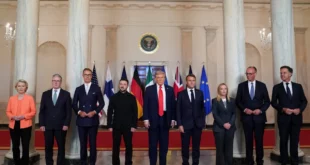Feuding factions on both sides of the Kyrgyz-Tajik border implemented a cease-fire on the evening of April 29 that ended some 24 hours of the worst and most widespread fighting the restive region has seen since the breakup of the Soviet Union.
Tensions between the Kyrgyz and Tajik communities along their common border have been building for years and evolved from fistfights to throwing sticks and stones and, more recently, to shoot-outs that sometimes involve mortars and grenade-launchers.
That was the case with the latest violence, which has left as many as two dozen dead and at least 150 wounded on both sides.
What Happened?
It started on April 28, in the Kyrgyz village of Kok-Tash, a known flashpoint for problems going back to January 2013 when a fight started in a store between a group of young Tajik men from Chorkuh and local Kyrgyz.
On April 29, fighting between local residents grew and, according to reports from Kyrgyzstan, Kyrgyz and Tajik security forces started exchanging gunfire.
Kyrgyzstan’s State Committee for National Security (UKMK) said the Tajik side was also using heavy machine guns and mortars.
That report was unable to be independently confirmed, but there were also reports of Tajik forces using mortars in these border disputes in January 2014 and May 2020.
But what’s significant is that this latest fighting spread to other areas along the border, something that did not previously happen.
Tajik security forces are reported to have taken control of areas along the road that leads from Tajikistan’s Vorukh exclave to Tajikistan proper. Kyrgyz villages along the route were deserted and many homes, shops, and vehicles had been burned.
Most of the thousands of Kyrgyz who fled the area have gone to the city of Batken, the regional capital.
The UKMK said Tajik forces attacked three Kyrgyz border posts — Kapchagai, Min-Bulak, and Dostuk — and the border checkpoints at Kojogar and Bulak-Bashi.
Several border posts were reportedly on fire.
RFE/RL’s Tajik Service, known locally as Ozodi, reported that the mayor of Isfara city, Bahovaddin Bahodurzoda, had a gunshot wound to the shoulder.
A correspondent from Ozodi said there were also casualties among Tajiks in Vorukh and the village of Khoja A’lo, but it was impossible to confirm as doctors and local officials had been told not to speak with the media.
How It All Began
This latest incident started when a small group of Tajik citizens were seen on the evening of April 28 trying to set up a monitoring camera at a water intake station at Kok-Tash.
The intake station releases water into canals going to Kyrgyzstan and Tajikistan.
Kyrgyz citizens confronted the Tajiks about the action. Angry words led to scuffles and then to stones being thrown, with people from Kok-Tash and nearby Khoja A’lo joining the fight.
Tajiks had been watching the intake station since April 17, when Kyrgyz workers were seen making repairs. The Tajiks lodged a protest that they had not been previously informed.
The repair work stopped, but the episode is an example of how these conflicts start.
As trust along this part of the border has waned, any unilateral attempt to build or repair roads or other infrastructure is quickly met with crowds of people from the other country demanding that the work stop.
There are always suspicions, particularly involving road work around the Vorukh exclave.
Anytime the Kyrgyz side starts work on the road in the area, the residents of Vorukh worry that it will lead to a route that detours around the exclave and could make it easy to totally cut off Vorukh from Tajikistan.
So Vorukh residents come out of the exclave and try to stop construction work.
As the Ozodi correspondent pointed out, the road is closed, so it is currently impossible for anyone from Tajikistan to reach Vorukh by car.
Any work on sources of water — canals or intake stations — brings the same response from either side.
Earlier in April, Kyrgyz authorities announced plans to construct a reservoir on a river (Kozu-Baglan in Kyrgyzstan and Khojaboqirgon in Tajikistan) that brings water to both countries.
Tajikistan quickly protested the plan, saying it could interfere with the flow of water to several districts in northern Tajikistan.
This area is particularly susceptible to such ethnic flare-ups because the people living there are the victims of a state border that did not exist during centuries of people living in this area.
The current configuration of the Kyrgyz-Tajik border is the product of Soviet mapmakers drawing the dividing lines for Soviet republics. After the U.S.S.R. collapsed in late 1991, these became the borders of independent countries.
Roads and waterways crisscross this border in many places and only some 504 kilometers of the approximately 970-kilometer Kyrgyz-Tajik frontier has been demarcated.
Talks on border demarcation have been slow, but the new leadership in Kyrgyzstan under President Sadyr Japarov has been actively and very publicly pushing negotiations to finish border talks with Uzbekistan and Tajikistan.
Kyrgyzstan’s UKMK is in charge of the country’s Border Guard Service.
The head of the UKMK, Kamchybek Tashiev, suggested at the end of March that part of a border deal with Tajikistan could include transferring ownership of the Vorukh exclave to Kyrgyzstan in exchange for land that is adjacent to Tajikistan.
The proposal angered some in Tajikistan and led to claims from the Tajik side that not only Vorukh but the lands around it were historically Tajik.
Tajik President Emomali Rahmon made a rare visit to Vorukh on April 7 and said there had never been and would never be any discussion of giving Vorukh to Kyrgyzstan.
Tashiev was not in Kyrgyzstan when the violence started on April 28, having left earlier to an unnamed country the same day for medical treatment.
No Good Way Out
The level of distrust was already sky-high between the two communities before the latest fighting.
These eruptions of violence along the Kyrgyz-Tajik border have been occurring sporadically for the last 15 years.
It started with rocks thrown at cars, cars being stopped and passengers beaten, then progressed to sticks and stones being thrown and orchards and homes being destroyed.
It has increasingly involved the police of the two countries, as well as border guards and soldiers, and has reached the point where guns are regularly used by both sides. Civilians are sometimes pulling the trigger.
As just happened again, officials from both countries rush to the site, agree to measures that aim to ease the tensions, promise to tell their forces not to use weapons, and send out officials to speak with the affected communities and calm them.
There have been joint border patrols, joint gatherings of residents for holidays, meetings of top government officials, meetings of local officials, and meetings of community leaders. But it seems very few residents of these border areas put any trust in a cease-fire or joint actions to ease tensions.
They never seem to last very long.
And worse, the scale of violence and use of weapons has gradually been increasing, making almost every new conflict a bit worse than the previous one.
 Eurasia Press & News
Eurasia Press & News



